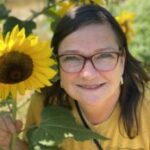 by Nancy Foote
by Nancy Foote
It’s always fun to put a new item on the curiosity table to see how my students will react. The newest addition was Arctic Flare UV Sensitive Putty, a gift from our friends at Educational Innovations.
 by Nancy Foote
by Nancy Foote
It’s always fun to put a new item on the curiosity table to see how my students will react. The newest addition was Arctic Flare UV Sensitive Putty, a gift from our friends at Educational Innovations.
 by Donna Giachetti
by Donna Giachetti
I have the great fortune of working for a company that inspires—indeed, requires—me to learn something new every day. I’m constantly scouring online science journals for tidbits on the latest in nanotechnology, the wonders of electrochemistry, or even something as relatively simple as the ultraviolet spectrum.
 By Priscilla Robinson
By Priscilla Robinson
This summer, during a visit to Mammoth Cave National Park in Kentucky, I had an experience that reminded me of why teachers and parents should emphasize good hygiene and disease prevention habits to our children. Whether fungal, bacterial, or viral, pathogens can be real threats to humans—and to wildlife. Preventing the spread of infectious disease is something we can ALL do, if we are taught the proper steps.

Non-Newtonian fluids are wonderful teaching tools for students of any age. Just bring some slime, honey, ketchup, or sour cream into your classroom and the learning begins! This fun lesson and worksheet makes it easy to teach students how to identify the properties of solids, liquids, and non-Newtonian fluids.
Lesson credit: University of Waikato, New Zealand (www.sciencelearn.org.nz).
Click on the image below for a full-size, printable PDF version of this 3-page lesson. Enjoy!
 by Dr. Kenneth Lyle
by Dr. Kenneth Lyle
The Poly Density Bottle is a fascinating demonstration primarily due to the phenomena being counterintuitive to what one would expect. The bottle containing white and blue beads suspended in a clear and colorless liquid is shaken vigorously, distributing the beads randomly throughout (bottle A). Upon standing, the beads separate from one another (bottle B) with the white rising to the surface while the blue sink to the bottom (bottle C). Then, the two sets of beads move towards one another (bottle D) meeting near the middle (bottle E). This demonstration can be easily repeated again and again. And, once prepared, it can be stored for subsequent use year after year. No additional preparation is required. Read the rest of this entry »